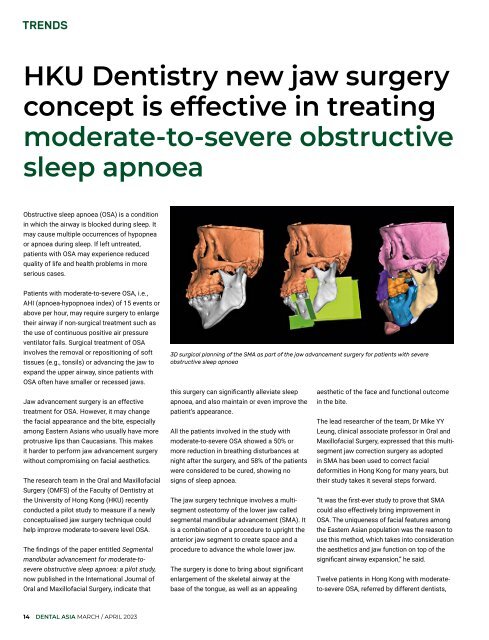Dental Asia March/April 2023
For more than two decades, Dental Asia is the premium journal in linking dental innovators and manufacturers to its rightful audience. We devote ourselves in showcasing the latest dental technology and share evidence-based clinical philosophies to serve as an educational platform to dental professionals. Our combined portfolio of print and digital media also allows us to reach a wider market and secure our position as the leading dental media in the Asia Pacific region while facilitating global interactions among our readers.
For more than two decades, Dental Asia is the premium journal in linking dental innovators
and manufacturers to its rightful audience. We devote ourselves in showcasing the latest dental technology and share evidence-based clinical philosophies to serve as an educational platform to dental professionals. Our combined portfolio of print and digital media also allows us to reach a wider market and secure our position as the leading dental media in the Asia Pacific region while facilitating global interactions among our readers.
Create successful ePaper yourself
Turn your PDF publications into a flip-book with our unique Google optimized e-Paper software.
TRENDS<br />
HKU Dentistry new jaw surgery<br />
concept is effective in treating<br />
moderate-to-severe obstructive<br />
sleep apnoea<br />
Obstructive sleep apnoea (OSA) is a condition<br />
in which the airway is blocked during sleep. It<br />
may cause multiple occurrences of hypopnea<br />
or apnoea during sleep. If left untreated,<br />
patients with OSA may experience reduced<br />
quality of life and health problems in more<br />
serious cases.<br />
Patients with moderate-to-severe OSA, i.e.,<br />
AHI (apnoea-hypopnoea index) of 15 events or<br />
above per hour, may require surgery to enlarge<br />
their airway if non-surgical treatment such as<br />
the use of continuous positive air pressure<br />
ventilator fails. Surgical treatment of OSA<br />
involves the removal or repositioning of soft<br />
tissues (e.g., tonsils) or advancing the jaw to<br />
expand the upper airway, since patients with<br />
OSA often have smaller or recessed jaws.<br />
Jaw advancement surgery is an effective<br />
treatment for OSA. However, it may change<br />
the facial appearance and the bite, especially<br />
among Eastern <strong>Asia</strong>ns who usually have more<br />
protrusive lips than Caucasians. This makes<br />
it harder to perform jaw advancement surgery<br />
without compromising on facial aesthetics.<br />
The research team in the Oral and Maxillofacial<br />
Surgery (OMFS) of the Faculty of Dentistry at<br />
the University of Hong Kong (HKU) recently<br />
conducted a pilot study to measure if a newly<br />
conceptualised jaw surgery technique could<br />
help improve moderate-to-severe level OSA.<br />
The findings of the paper entitled Segmental<br />
mandibular advancement for moderate-tosevere<br />
obstructive sleep apnoea: a pilot study,<br />
now published in the International Journal of<br />
Oral and Maxillofacial Surgery, indicate that<br />
3D surgical planning of the SMA as part of the jaw advancement surgery for patients with severe<br />
obstructive sleep apnoea<br />
this surgery can significantly alleviate sleep<br />
apnoea, and also maintain or even improve the<br />
patient’s appearance.<br />
All the patients involved in the study with<br />
moderate-to-severe OSA showed a 50% or<br />
more reduction in breathing disturbances at<br />
night after the surgery, and 58% of the patients<br />
were considered to be cured, showing no<br />
signs of sleep apnoea.<br />
The jaw surgery technique involves a multisegment<br />
osteotomy of the lower jaw called<br />
segmental mandibular advancement (SMA). It<br />
is a combination of a procedure to upright the<br />
anterior jaw segment to create space and a<br />
procedure to advance the whole lower jaw.<br />
The surgery is done to bring about significant<br />
enlargement of the skeletal airway at the<br />
base of the tongue, as well as an appealing<br />
aesthetic of the face and functional outcome<br />
in the bite.<br />
The lead researcher of the team, Dr Mike YY<br />
Leung, clinical associate professor in Oral and<br />
Maxillofacial Surgery, expressed that this multisegment<br />
jaw correction surgery as adopted<br />
in SMA has been used to correct facial<br />
deformities in Hong Kong for many years, but<br />
their study takes it several steps forward.<br />
“It was the first-ever study to prove that SMA<br />
could also effectively bring improvement in<br />
OSA. The uniqueness of facial features among<br />
the Eastern <strong>Asia</strong>n population was the reason to<br />
use this method, which takes into consideration<br />
the aesthetics and jaw function on top of the<br />
significant airway expansion,” he said.<br />
Twelve patients in Hong Kong with moderateto-severe<br />
OSA, referred by different dentists,<br />
14 DENTAL ASIA MARCH / APRIL <strong>2023</strong>


















